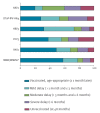Timeliness and completeness of routine childhood vaccinations in young children residing in a district with recurrent vaccine-preventable disease outbreaks, Jerusalem, Israel
- PMID: 30755293
- PMCID: PMC6373067
- DOI: 10.2807/1560-7917.ES.2019.24.6.1800004
Timeliness and completeness of routine childhood vaccinations in young children residing in a district with recurrent vaccine-preventable disease outbreaks, Jerusalem, Israel
Abstract
BackgroundChildhood vaccination schedules recommend vaccine doses at predefined ages.AimWe evaluated vaccination completeness and timeliness in Jerusalem, a district with recurrent vaccine-preventable disease outbreaks.MethodsVaccination coverage was monitored by the up-to-date method (vaccination completeness at age 2 years). Timeliness of vaccination was assessed in children (n = 3,098, born in 2009, followed to age 48 months, re-evaluated at age 7 years) by the age-appropriate method (vaccine dose timeliness according to recommended schedule). Vaccines included: hepatitis B (HBV: birth, 1 month and 6 months); diphtheria, tetanus, acellular pertussis, polio, Haemophilus influenzae b (DTaP-IPV-Hib: 2, 4, 6 and 12 months); pneumococcal conjugate (PCV: 2, 4 and 12 months); measles-mumps-rubella/measles-mumps-rubella-varicella (MMR/MMRV: 12 months) and hepatitis A (HAV: 18 and 24 months).ResultsOverall vaccination coverage (2014 cohort evaluated at age 2 years) was 95% and 86% for MMR/MMRV and DTaP-IPV-Hib4, respectively. Most children (94%, 91%, 79%, 95%, 92% and 82%) were up-to-date for HBV3, DTaP-IPV-Hib4, PCV3, MMR/MMRV1, HAV1 and HAV2 vaccines at 48 months, but only 32%, 28%, 38%, 58%, 49% and 20% were vaccinated timely (age-appropriate). At age 7 years, the median increase in vaccination coverage was 2.4%. Vaccination delay was associated with: high birth order, ethnicity (higher among Jews vs Arabs), birth in winter, delayed acceptance of first dose of DTaP-IPV-Hib and multiple-dose vaccines (vs MMR/MMRV). Jewish ultra-Orthodox communities had low vaccination coverage.ConclusionsConsiderable vaccination delay should be addressed within the vaccine hesitancy spectrum. Delays may induce susceptibility to vaccine-preventable disease outbreaks; tailored programmes to improve timeliness are required.
Keywords: childhood vaccination; children; infants; measles; routine vaccinations; toddlers; vaccination completeness; vaccination coverage; vaccination schedules; vaccination timeliness; vaccines and immunisation.
Conflict of interest statement
Figures




References
-
- World Health Organization (WHO). Immunization coverage. Geneva: WHO; 2018. Available from: http://www.who.int/mediacentre/factsheets/fs378/en/
-
- World Health Organization (WHO). Global Vaccine Action Plan. Geneva: WHO; 2015. Available from: http://www.who.int/immunization/global_vaccine_action_plan/gvap_secretar...
MeSH terms
Substances
LinkOut - more resources
Full Text Sources
Medical
Molecular Biology Databases
